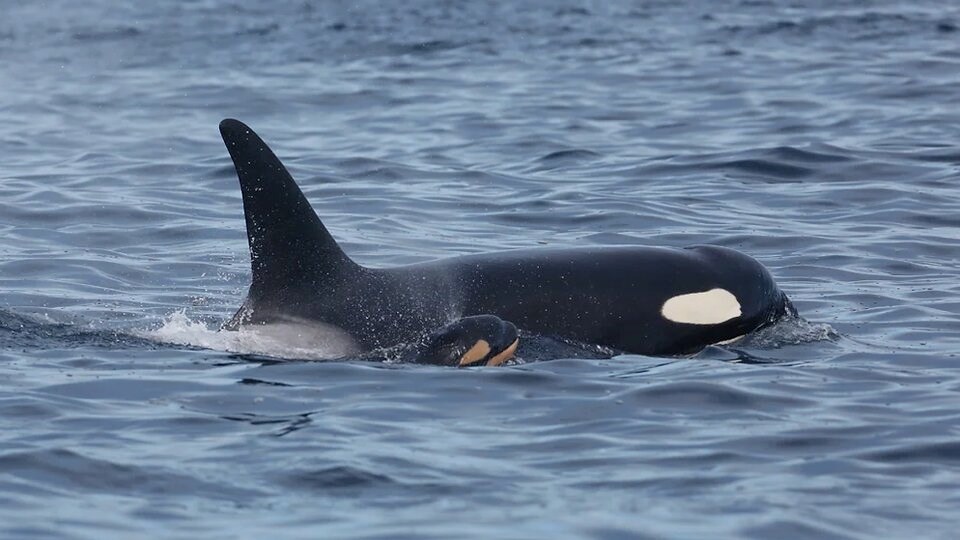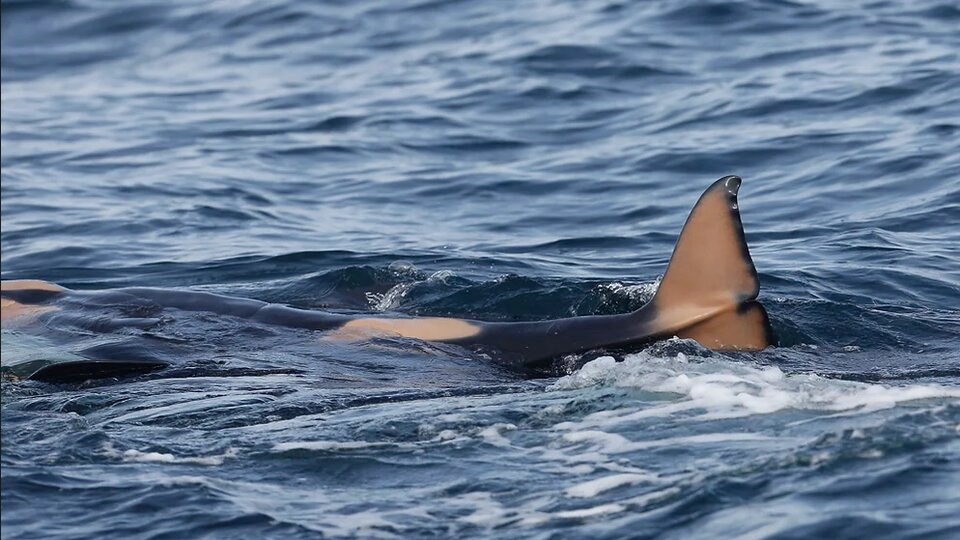The latest calf to boost B.C.’s southern resident killer whale population has been found off the southern tip of 91ԭ�� Island emaciated and struggling to breathe, according to the Center for Whale Research, based in Washington state.
On Oct. 5, one of the centre’s biologists, Mark Malleson, received a report that J Pod had been seen in Admiralty Inlet that morning. He jumped in a boat and left Victoria Harbour hoping to see the mother and calf — known as L90 and L128, respectively — reunited with the rest of the clan.
“At 12:22, as Mark approached the eastern edge of Swiftsure Bank, he spotted his first dorsal fin amidst the flurry of seabirds and humpback whales,” noted the centre in description of the encounter.
Malleson saw several whales foraging when a half dozen individuals started to approach him, including “a very small calf tucked alongside them.”

The centre’s staff had photographed L128 a couple of weeks earlier off San Juan Island on the U.S. side of the international border. The small, emaciated calf appeared “lumpy and skinny.”
As the mother approached the boat, she supported the calf with her head.
“Mark’s heart sank — he was certain the calf had stopped breathing,” notes the report of the encounter.
Another whale jiggled the calf, as if desperately trying to revive it, and as it continued past the stern of the boat Malleson thought he saw the calf take a faint breath.
An hour after the encounter, Malleson turned the boat around and started the 60-nautical-mile trip back to Victoria harbour “emotionally drained.”

Peter Ross, marine mammal toxicologist with the Raincoast Conservation Foundation who has been studying killer whales for nearly 30 years, says finding a calf in such dire straits is a good reminder of the threats facing the southern resident killer whale population.
“Of course, it’s deeply distressing when we hear about a calf in distress when we have an endangered population in trouble,” said Ross.
Ross cautioned, however, not to put too much stock in the declining health of a single whale. He said roughly a quarter of newborn whales die in their first year of life.
“Is this a one off? Is this Mother Nature? Is it a genetic anomaly,” Ross said. “It’s a tough time. It’s a tough world. They have to be born armed and ready for the ocean, and that’s exacerbated by human disturbance.”
Numbers of southern residents, which range from California to B.C., have stagnated at around 75 individuals for decades.
The genetically distinct population was listed as endangered in Canada under the Species at Risk Act in 2003. As of July 1, 2024, researchers had counted 73 whales across three pods, including 25 in J Pod, 15 in K Pod, and 33 in L Pod.
Some studies have found high levels of wildfire and fossil-fuel toxins in the southern population’s fatty layers. Research has also looked at the impact of and how underwater sounds from industrial activity and could be messing with their navigation.
One of the most active areas of current research is assessing whether the whales are getting enough chinook salmon — the southern residents’ preferred food.
Food shortages could be occurring outside summer or further south
The encounter comes as scientists released a this week analyzing food availability — in particular, chinook salmon — of the southern resident killer whales.
In a study published in the journal PLOS One Thursday, University of British Columbia researchers Burak Saygili and Andrew Trites surveyed fishers and whale watching groups to find the whales’ chinook -feeding hot spots.
In the summer of 2020, they used sonar to estimate the density of fish in both southern resident and their northern resident cousins.
The researchers found chinook salmon were twice as prevalent in the hot-spots of the southern populations when compared to the northern residents — even though the latter are consistently found to be healthier and more abundant.
The results, notes the study, is that southern resident killer whales have greater access to chinook salmon during summer months, and that food shortages occur at other times of year or outside the Salish Sea, such as the coastlines of Oregon and California.
Another possibility is that even with an abundance of chinook in feeding hotspots, the southern residents may have trouble accessing them due to acoustic or physical disturbances from vessels.
Ross, who wasn’t involved in the research, said despite the relative densities of chinook, the overall population has seen dramatic declines in recent years.
“If the mother is having trouble finding an adequate food, she’s going to struggle providing enough milk,” he said.


